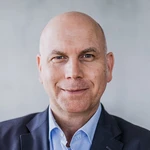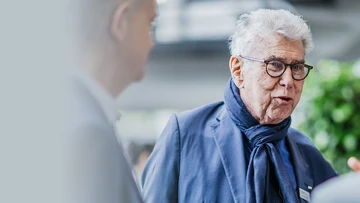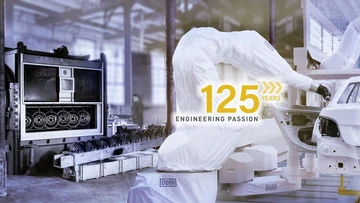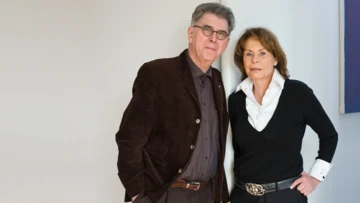Heinz Dürr was born in Stuttgart in 1933. After finishing secondary school, he completed an apprenticeship as a steel fitter and then went on to study mechanical engineering. His first stop in the family business journey was the engineering department. His father, Otto Dürr, was Managing Director at the time, while his mother, Betty, was respected as the 'commercial conscience'. After the war, Dürr underwent great changes: the sheet-metal working specialist became an industrial company, focusing on equipment engineering and surface processing. The foundation stone for Dürr's current position as a world-market leader was laid by its surface and paint systems business.
At the age of 27, Heinz Dürr joined the management team. Business with the automotive industry was expanded. The owner's son boldly forged ahead with the company's internationalization. In 1964, the first foreign subsidiary was established in Brazil. Under the management of 'HD', Dürr built the first complete car body paint shop for Volkswagen in São Paulo. Further companies were founded in the UK, France, Spain, Italy, Austria, Mexico, the United States, South Africa, India and China, among other countries. Together with his wife Heide, Heinz Dürr gave the corporate culture a modern edge. Dürr was one of the first industrial companies with an employee newsletter, a library, art in the buildings as well as theater and concert performances in the factory.
In 1975, at the proposal of Hanns-Martin Schleyer, Heinz Dürr became Chairman of the Employers' Association for the Metal Industry of North Baden / North Württemberg. He negotiated innovative collective bargaining agreements with Franz Steinkühler, head of the metalworkers' union IG-Metall; the strike in 1978 that had lasted several weeks had nationwide significance.
AEG, Deutsche Bahn and Carl Zeiss Foundation
In 1980, Heinz Dürr stepped down as CEO of his company and became head of the ailing electrical company AEG. Aside from the entrepreneurial challenge, it was AEG's technological potential that appealed to him. The surprising move had been initiated by the then head of Bosch, Hans Lutz Merkle. Heinz Dürr guided AEG through a settlement and brought it under the control of Daimler-Benz AG in 1985, where he joined the Board of Management in 1986.
In 1990, Heinz Dürr floated his family business on the stock market as Dürr AG. The proceeds were used to acquire application technology specialist Behr, which went on to become Dürr's successful painting robot division.
In 1991, at the request of German Chancellor Helmut Kohl, Heinz Dürr took over as CEO of Deutsche Bundesbahn (German Federal Railway) – a job in the public eye, as had been the case with AEG. As part of the railway reform, he promoted the merger between Bundesbahn and the East German Reichsbahn and its transformation from a state-owned group into the service company Deutsche Bahn AG. In 1997, the 64-year-old joined the Deutsche Bahn AG's Supervisory Board and was its Chairman until 1999. From 1999 to 2003, Heinz Dürr was Commissioner of the Carl Zeiss Foundation. The reform he led there also proved very successful.
The company as a social event
The self-perception of Heinz Dürr, as an entrepreneur who focuses on the common good, goes back to Ernst Abbe and Walter Rathenau, the historic business figures at Zeiss and AEG. Heinz Dürr’s reference points also include the former head of Deutsche Bank, Hermann Josef Abs, and the philosopher Odo Marquard. His economic thinking revolves around the notion of the "company as a social event". A company has a responsibility toward its employees and society. "It must deliver proper products and services which society needs. It should look after the people in the company and make sure that those who give the company money receive a decent return." Profit is not an end in itself, "but it is necessary to prevent the company from becoming a burden, usually to the tax payer."
Heinz Dürr sees himself as a committed SME-entrepreneur. To him, SME means "personal instead of technocratic leadership. The company boss knows his staff and talks to them". In keeping with his Swabian mentality, Dürr always advises his employees to be modest. "Those who think they are somebody will stop becoming somebody."
From 1990 to 2013, Heinz Dürr was Chairman of the Dürr AG Supervisory Board. Since 2006, Prof. Dr. Dr. Alexandra Dürr, one of Heinz and Heide Dürr’s three daughters, has represented the family, which holds a 29 % share, on the Supervisory Board. Being Honorary Chairman of the Supervisory Board, Heinz Dürr stays in close contact with the company. From his base in Berlin, the entrepreneur often visits various locations in Germany and abroad. His advice is still in demand today.
In 1998, the entrepreneur and his wife set up a foundation, Heinz und Heide Dürr Stiftung, based on Section 14 of the German Constitution: "Property entails obligations. Its use shall also serve the public good." The foundation focuses mainly on science and research, early education and German-speaking theater.
Being an avid reader, Heinz Dürr admires the Austrian author Thomas Bernhard, and has written two books himself: "In der ersten Reihe – Aufzeichnungen eines Unerschrockenen" (In the front row – notes from a dauntless man) and "Über das Alter – Ein Gespräch mit Cato über Jugendwahn, Weisheit und Vergänglichkeit" (Talking about age – a conversation with Cato on the obsession with youth, on wisdom and on transience). In his books, he reflects – sometimes tongue in cheek – on his career and on getting older. Heinz Dürr, whose office is on Berlin's Gendarmenmarkt square, is as attached to Germany's capital as he is to his Swabian home province.






